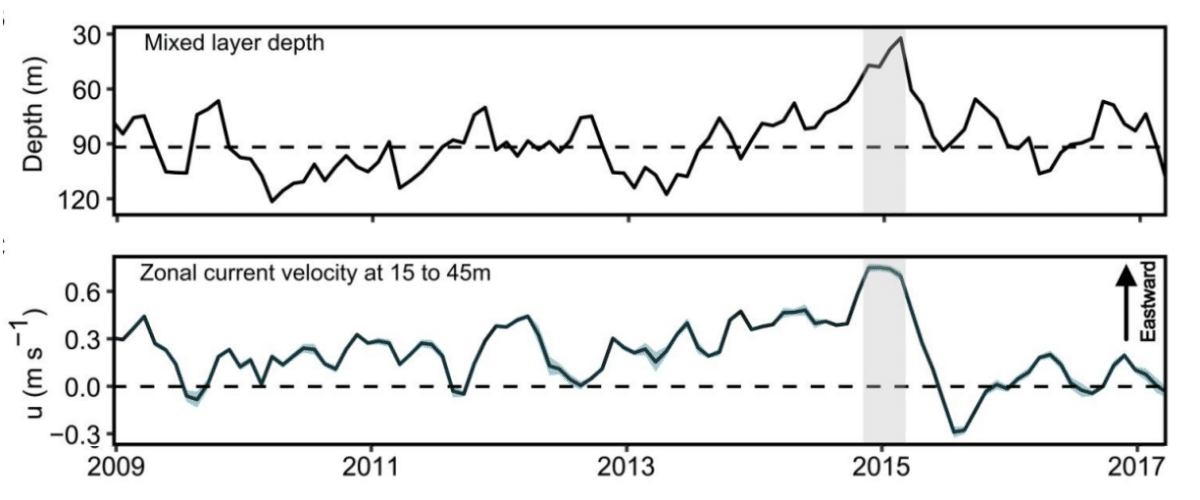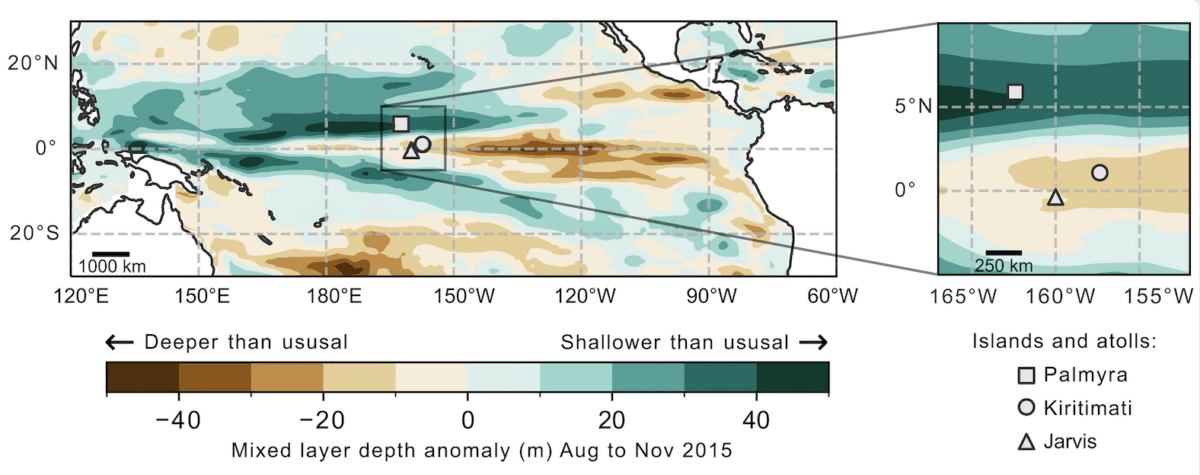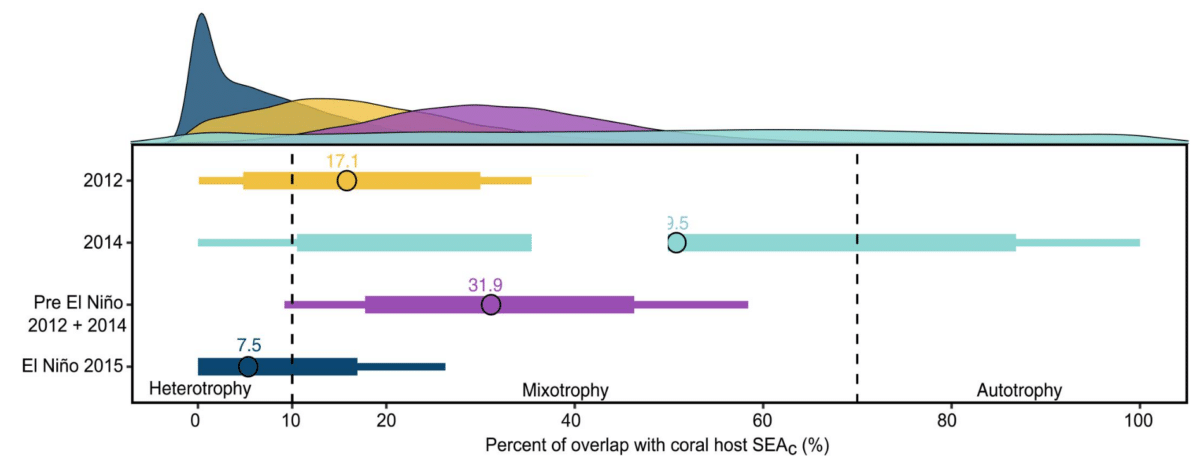An unexpected benefit for some Pacific corals of El Niño?
Over the past 30 years, marine heat waves have become increasingly frequent, intense and long, and it’s highly likely that this trend will increase with global warming (Frölicher, 2018).
What are marine heat waves? The precise definition of these events can vary from one study to another, but scientists agree that they are episodes lasting at least five days (and up to several months) when the sea surface temperatures are above the historical average (at least 30 years data) (Hobday et al., 2016; Viglione, 2021). They can occur as a result of complex oceanic or atmospheric dynamics, such as the El Niño phenomenon (Claar et al., 2018).
El Niño is a natural climatic event involving a reversal of ocean currents in the Pacific. This results in a rise in temperatures along the South American coast and a change in temperatures across the globe. This event occurs approximately every 2 to 7 years, although more extreme events have been reported in the last decades (Cai et al., 2014). The consequences of El Niño are far-reaching, both in socio-economic terms, with a heavy impact on fishing activities, and in environmental terms, with diverse effects on marine and terrestrial ecosystems. In coral reef areas, marine heat waves during this phenomenon lead to successive and widespread mass bleaching events, especially the one reported in 2015-2016 with unprecedented thermal stress (Claar et al., 2018 ; Fox et al., 2023).
An international team of researchers led by Dr. Michael Fox from KAUST University wanted to investigate the local repercussions of heat waves on local ocean processes, and how this impacts corals’ trophic ecology (what they eat). To do this, they focused on coral reefs at Palmyra Atoll in the Pacific Ocean, before and after the El Niño phenomenon in 2015-2016. Their research showed unexpected results: oceanographic changes during El Niño allowed corals in this location to have access to supplementary nutritional sources during heat waves, unveiling a new mechanism that operates in corals’ favor (Fox et al., 2023). How does it work? Here, we explain some of the results of their research.
The oceanographic aspect: what happens with El Nino?
For their study, Fox’s team described the local oceanic repercussions of El Niño in Palmyra Atoll (Central Pacific), and then made the link with corals. They observed oceanographic dynamics using 2 distinct variables: the speed of the North Equatorial Counter Current (*see glossary below) and the depth of the oceanic mixing layer (*see glossary below).
They observed anomalies in both of these parameters during the 2015 El Niño (shaded area in Fig. 1), reflecting an upwelling of deep, cold, nutrient-rich water to the surface. Indeed, the depth of the mixing layer has never been so shallow (around 15 m, compared with an average depth of 90 m, higher panel, Fig. 1), and current velocity has reached 0.6 m/s, compared with an average of 0.3 m/s the rest of the time (lower panel, Fig. 1).
First finding: in Palmyra Atoll, during the 2015 El Nino phenomenon, a local upwelling of cool, nutrient-rich water was reported (Fox et al., 2023).
This was not the case on all the islands in the region: in other localities, oceanographic parameters do not point towards the occurrence of upwelling (Fig. 2), and indeed coral mortality in these areas was higher than in Palmyra, demonstrating the complexity of the climatic phenomenon (Fox et al. 2023).

Figure 1: Graph showing the thinning of the surface layer (top) to the increase in North Equatorial Counter Current velocity (bottom) during the 2015 El Niño. Taken and adapted from Fox et al., 2023.

Figure 2: Graph showing the regional variation of the mixed layer depth anomaly in the Pacific between August and November 2015, compared with the period 1980-2020. Colors: towards brown, the mixed layer is deeper than usual, and towards blue, the layer is shallower than usual. Taken and adapted from Fox et al., 2023.
How do corals respond?
Scientists wanted to know how coral food sources varied with upwelling in Palmyra Atoll.
Therefore, they studied the trophic ecology of a species of hard coral (Pocillopora meandrina) before and after El Niño phenomenon of 2015-2016. This coral species, like most tropical corals, is mixotrophic, meaning it has 2 feeding sources. Corals receive nutrients through photosynthesis by their microalgae (autotrophy), and can hunt for food in their environment (heterotrophy). The choice of food source can vary according to the availability of resources in the environment.
In the study, researchers observed a shift to heterotrophy in corals during El Niño in 2015 (Fig. 3). This shift cannot be explained by the loss of symbiosis with the microalgae, as no coral bleaching was observed. This dietary change can therefore be explained by an increase in the presence of nutrients available to coral during El Niño, coming from the described upwelling.
Second result: deep waters brought to the surface by upwelling will provide corals with a new source of food, supplementary to autotrophy-derived nutrients. This phenomenon will favor corals that have a flexible trophic strategy and can transition to heterotrophy, which is an additional nutritional input for corals.

Figure 3: Graph showing transitions to heterotrophy during the El Niño events of 2012, 2014 and 2015. Taken and adapted from Fox et al., 2023.
On top of this, upwelling is associated with brief, intense pulses of cold water. These would have a cooling effect on waters below 15 m in depth, which increases with depth. Although our understanding of the impact of these “cold pulses” on coral cooling remains limited, the hypothesis that upwelling provides corals with a thermal refuge during El Niño is not ruled out.
In conclusion, the research suggests that these two local oceanographic mechanisms described at Palmyra Atoll during El Niño, nutrient supply and thermal refuge, contribute to limit the thermal stress and coral bleaching, which would make them more resilient to the extreme conditions to which they are exposed, in the face of climate change. Nevertheless, the El Niño phenomenon remains a very complex event from a global point of view, and with huge impacts on coral reefs. Understanding its effects on a local or regional scale to better predict the vulnerability of reefs to climate change remains fundamental.
Glossary:
The North Equatorial Counter Current: is a current that flows from west to east at about 3-10°N in the Atlantic, Indian Ocean and Pacific basins.
The oceanic mixed layer: this is the most superficial layer of the ocean in which the water is homogeneous in terms of salinity, temperature, and density. It interacts directly with the atmosphere.
Cited articles:
Cai W, Borlace S, Lengaigne M et al.(2014) Increasing frequency of extreme El Niño events due to greenhouse warming. Nature Clim Change 4, 111–116. https://doi.org/10.1038/nclimate2100
Claar DC, Szostek L, McDevitt-Irwin JM, Schanze JJ, Baum JK (2018) Global patterns and impacts of El Niño events on coral reefs: A meta-analysis. PLoS ONE 13(2): e0190957. https://doi.org/10.1371/journal.pone.0190957
Fox MD, Guillaume-Castel R, Edwards CB, Glanz J, Gove JM, Green JAM, Juhlin E, Smith JE, Williams GJ. (2023) Ocean currents magnify upwelling and deliver nutritional subsidies to reef-building corals during El Niño heatwaves. Sci Adv. 9(24):eadd5032. doi: 10.1126/sciadv.add5032. Epub 2023 Jun 14. PMID: 37315146; PMCID: PMC10266739.
Frölicher TL, Fischer EM & Gruber N (2018) Marine heatwaves under global warming. Nature 560, 360–364. https://doi.org/10.1038/s41586-018-0383-9
Hobday AJ, Alexander LV, Perkins SE, Smale DA, Straub SC, et al. (2016). A hierarchical approach to defining marine heatwaves. Prog. Oceanogr. 141:227–38 https://doi.org/10.1016/j.pocean.2015.12.014
Viglione, G. (2021, Mai 5). Fevers are plaguing the oceans — and climate change is making them worse. Nature, 593, 26-28. doi: https://doi.org/10.1038/d41586-021-01142-4
Ces articles pourraient vous intéresser

Do clouds support us in coral protection?
Mystery in the Pacific: who saved coral reefs at the Society Islands? Could the presence of clouds in the sky improve the health of coral…
28 November 2023
Climate-impacted reefs may continue to supply vital micronutrients through fisheries
Acknowledgements to James Robinson. Coral reefs rank among the most productive and diverse ecosystems on Earth – including more than 700 coral species and…
30 March 2022
